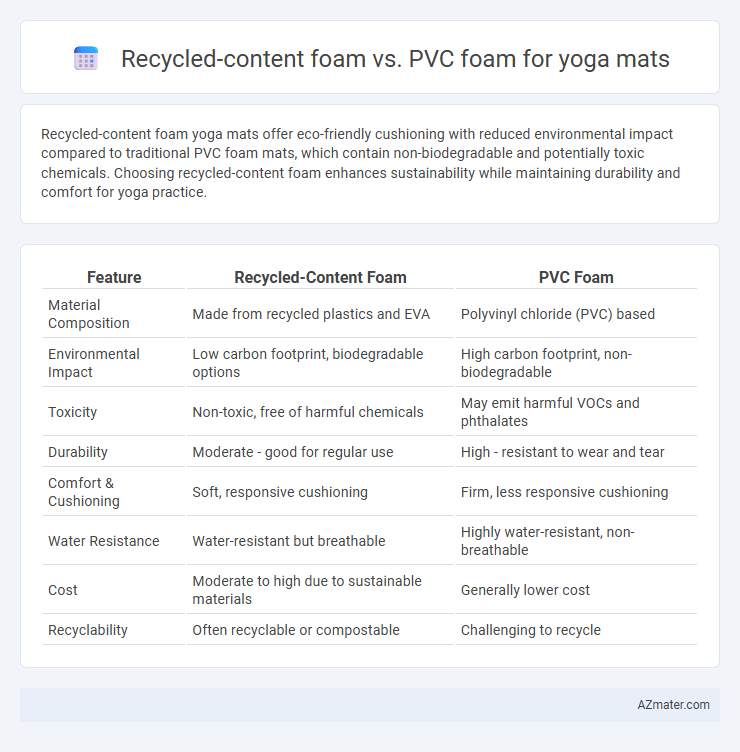Recycled-content foam yoga mats offer eco-friendly cushioning with reduced environmental impact compared to traditional PVC foam mats, which contain non-biodegradable and potentially toxic chemicals. Choosing recycled-content foam enhances sustainability while maintaining durability and comfort for yoga practice.
Table of Comparison
| Feature | Recycled-Content Foam | PVC Foam |
|---|---|---|
| Material Composition | Made from recycled plastics and EVA | Polyvinyl chloride (PVC) based |
| Environmental Impact | Low carbon footprint, biodegradable options | High carbon footprint, non-biodegradable |
| Toxicity | Non-toxic, free of harmful chemicals | May emit harmful VOCs and phthalates |
| Durability | Moderate - good for regular use | High - resistant to wear and tear |
| Comfort & Cushioning | Soft, responsive cushioning | Firm, less responsive cushioning |
| Water Resistance | Water-resistant but breathable | Highly water-resistant, non-breathable |
| Cost | Moderate to high due to sustainable materials | Generally lower cost |
| Recyclability | Often recyclable or compostable | Challenging to recycle |
Introduction: Why Material Choice Matters for Yoga Mats
Choosing the right material for a yoga mat directly impacts durability, comfort, and environmental footprint. Recycled-content foam enhances sustainability by reducing waste and lowering carbon emissions compared to virgin PVC foam. PVC foam, while affordable and water-resistant, poses environmental concerns due to its non-biodegradable nature and toxic manufacturing processes.
Understanding Recycled-Content Foam Yoga Mats
Recycled-content foam yoga mats are made from post-consumer or post-industrial materials, reducing waste and environmental impact compared to traditional PVC foam mats, which are derived from non-renewable petroleum resources. These eco-friendly mats often use materials such as recycled EVA or natural rubber, offering durability, cushioning, and non-toxic properties without harmful chemical off-gassing associated with PVC. Choosing recycled-content foam mats supports sustainable manufacturing and provides a healthier practice surface, aligning with eco-conscious consumer priorities in the yoga industry.
What Is PVC Foam? Key Features and Composition
PVC foam, or polyvinyl chloride foam, is a lightweight, durable material commonly used in yoga mats for its high resilience and cushioning properties. Its composition includes a polymer matrix filled with gas bubbles that create a closed-cell structure, providing excellent water resistance, chemical stability, and durability. Key features of PVC foam include flexibility, shock absorption, and resistance to wear, making it a popular choice for yoga mats requiring long-lasting performance and comfort.
Environmental Impact: Recycled-Content Foam vs PVC Foam
Recycled-content foam yoga mats significantly reduce environmental impact by using post-consumer or post-industrial waste, lowering landfill contributions and conserving natural resources. In contrast, PVC foam production involves harmful chemicals and generates toxic emissions, posing risks to ecosystems and human health during manufacturing and disposal. Choosing recycled-content foam supports sustainability by minimizing pollution and promoting circular economy principles compared to traditional PVC foam mats.
Durability and Longevity: Which Yoga Mat Lasts Longer?
Recycled-content foam yoga mats typically offer enhanced durability due to their dense, eco-friendly materials that resist compression and wear over time. PVC foam mats, while initially more affordable and providing excellent cushioning, tend to degrade faster with frequent use, showing signs of cracking and loss of elasticity. Long-term performance studies indicate that recycled-content foam mats maintain structural integrity and cushioning properties considerably longer, making them a more sustainable choice for lasting yoga practice.
Comfort and Cushioning Differences
Recycled-content foam yoga mats offer superior cushioning through enhanced elasticity and responsive support, absorbing impact effectively during poses and providing long-lasting comfort. PVC foam mats tend to be denser and firmer, delivering moderate cushioning but often feeling less breathable and flexible compared to recycled foams. The open-cell structure of recycled foams improves shock absorption and joint comfort, making them ideal for extended practice sessions requiring softness and pressure relief.
Health and Safety Considerations
Recycled-content foam yoga mats offer enhanced health benefits by reducing exposure to harmful chemicals commonly found in PVC foam, such as phthalates and volatile organic compounds (VOCs). PVC foam mats can emit toxic fumes during manufacturing and use, posing respiratory risks and potential skin irritation. Choosing recycled-content foam supports a safer, non-toxic exercise environment while minimizing environmental impact.
Cost Comparison: Affordable Options and Value
Recycled-content foam yoga mats offer an affordable alternative to PVC foam, often priced 10-30% lower due to lower raw material costs and sustainable sourcing. While PVC foam mats provide durability and cushioning, recycled foam mats deliver comparable comfort and performance at a reduced price point, enhancing value for eco-conscious consumers. Investing in recycled-content foam mats supports sustainable practices without compromising on the essential cost-effectiveness and quality expected in yoga accessories.
User Experience & Customer Reviews
Recycled-content foam yoga mats are praised for their eco-friendly materials and softer, more cushiony feel, enhancing comfort during extended practice sessions. Customers frequently highlight the non-toxic, odor-free quality and superior grip of recycled foam mats, improving stability and overall user experience. In contrast, PVC foam mats often receive mixed reviews due to their chemical smell and lesser environmental appeal, though their durability and affordability remain positive points for some users.
Conclusion: Choosing the Best Yoga Mat Material
Recycled-content foam yoga mats offer eco-friendly benefits, durability, and excellent cushioning, making them ideal for environmentally conscious practitioners seeking comfort. PVC foam mats provide high resilience, affordability, and strong grip but pose environmental concerns due to non-biodegradability and toxic chemical usage. Selecting the best yoga mat material depends on prioritizing sustainability and comfort with recycled-content foam or opting for cost-effective performance with PVC foam.

Infographic: Recycled-content foam vs PVC foam for Yoga mat
 azmater.com
azmater.com